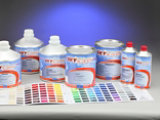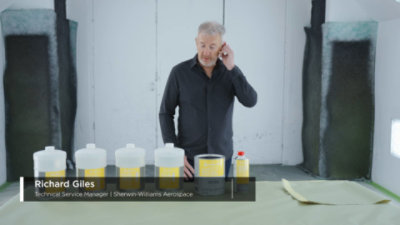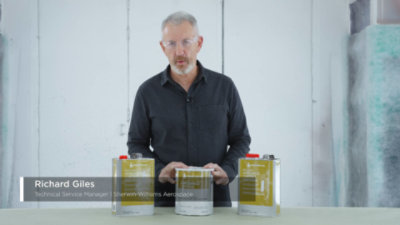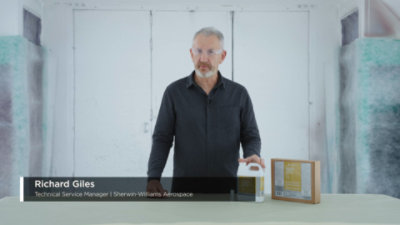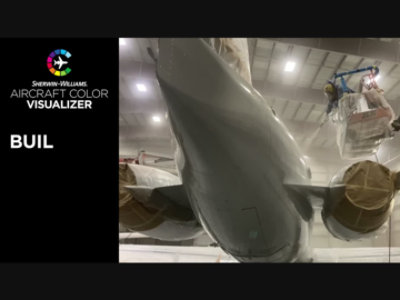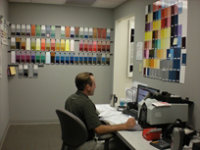00:00:07:19 - 00:00:39:22
Unknown
The product shown here is on next gen non chrome epoxy primer. It's a two to 1 to 1 ratio. Very simple mixing. You'll notice that this is a three component chemistry. Typically with epoxies you have the base the attraction the solvent. This actually is three part chemistry. The reason is three part chemistry. It's got superb anti corrosive properties test very well as far as spray coating goes.
00:00:39:23 - 00:01:14:14
Unknown
You can use conventional pressure pot whatever you have in the shop. Each stock of course that's without saying great wet edge. It's very important on a primer that you have a great wet edge for that very smooth surface. This is purely a corrosion package primer. You wouldn't want to use this as a surface. We have surface eruptions, but certainly with this product under any pre-treat that's currently on the market, we'll get the exceptional corrosion resistance.
00:01:17:06 - 00:01:47:16
Unknown
This is the noncurrent program. Only discussed like any base. Always mechanically shake this and stir it. They don't settle, but they do get thick. So, mechanically shake this base until it's a nice homogeneous consistency. A top tip when you when you're taking proportions out of the car and you're using a quart, container, what I always do is mark it ahead of time, two to 1 to 1.
00:01:47:17 - 00:01:56:19
Unknown
In this case, what it stops you doing is guessing. Just clean marks, base first adduct and then solvents.
00:01:56:19 - 00:02:00:04
Unknown
So this is where we are.
00:02:04:12 - 00:02:15:23
Unknown
Going in this case it's, two to 1 to 1 to base one I that's one thinner or one activator in this case.
00:02:16:02 - 00:02:25:01
Unknown
Is the hardener. So these are these are big mouth cans. So they're very easy to, dispense.
00:02:25:01 - 00:02:49:05
Unknown
you notice here it is. Yellow, like a typical addict. Don't have any concern with that, or it's not meant to be clear. So. And we go the again up to the preset mark saves any guesswork. And looking at and probably over filling between the ratios. So that's spot on to the mark.
00:02:49:05 - 00:02:58:02
Unknown
We can use this mixing vessel because it's all part of the same chemistry in the kit.
00:02:58:04 - 00:03:07:17
Unknown
And I like most activators. If you look at this it is clear. It looks like, just a pure solvent. It's not of course, but it looks like one.
00:03:07:17 - 00:03:16:21
Unknown
Once it's stirred, we do require an induction time. 15 minutes. Usually. Not a long time.
00:03:16:21 - 00:03:21:00
Unknown
So let's stir it until we get a nice consistency.
00:03:22:05 - 00:03:40:08
Unknown
Now this time you can take viscosities if you wish. This is a volumetric system. However, the cost is important. And like anything else on the other materials, if you're using part, part material, write down the activation time so, you know, it's still in life.
00:03:40:10 - 00:04:05:15
Unknown
Now the again, we're back to the 120 fives, which was very useful. Filter grade. It will take take out most debris. So you can filter in if you wish and then filter out, whatever your preference, whatever your work, process will be. But you certainly have got to filter, at some point in the mix.
00:04:09:04 - 00:04:33:01
Unknown
Application of this. Again we're looking for about one mil 1.2 dry foam. We're not looking for high foam. Well we're looking for that closed foam coat. This dries remarkably well to a very low profile. This is a non sand product. So you can go straight on with top coat if you wish.
00:04:33:03 - 00:04:45:20
Unknown
If you wish at this feature you inclusions you can do that. But primarily this is a low foam non sand primer. And we're going to paint the rest of these panels.
00:04:45:20 - 00:05:11:13
Unknown
So what does a good non sun primer need. Well first it first of all it needs a good white edge. It's vital that when you're painting a frame the overspray generated actually soaks into itself. If we can look I don't know whether we can catch this, but if we look at the profile it's actually flat and level. Again, for a non sun primer
00:05:11:13 - 00:05:18:04
Unknown
the profile is absolutely critical with all top coats.
00:05:18:05 - 00:05:43:06
Unknown
It will to a two degree follow the profile. So the smaller the profile the flatter the profile the top coat. It gives a chance for the top coat to collapse and level without real influence of the primer. Trying to recover a primer profile. So as we can see with this, an extended wet edge for the poxy primer. It repairs.
00:05:43:06 - 00:05:55:14
Unknown
Well, it blows in well, you don't get any furring around the edge, which is typical a nut, profile is perfect. A great canvas for any topcoat system.
